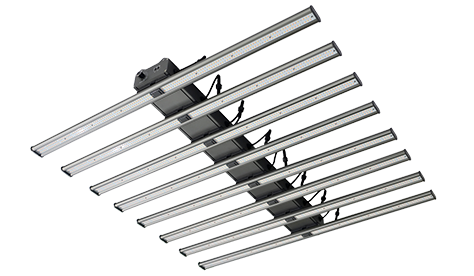Plant led grow lights are used to match the light saturation points and light compensation points of different plants. The light saturation point and light compensation point of plants vary depending on the crop type and cultivation conditions. Some negative plants reach light saturation in less than 10,000 lux, while positive plants require tens of thousands of luces to reach saturation. Some four-carbon (C) plants are often not fully saturated by midday direct sunlight (about 100,000 lux), and generally, the light saturation point of three-carbon (Ca) plants is lower than that of four-carbon (C,) plants.

Plants were grown due to lack of sunlight in the environment, such as basement and balcony plantings. Artificial light (plant light) must be used instead of sunlight to provide plants with the energy needed for photosynthesis, and the light intensity of the required light source must reach above the light compensation point required for normal plant growth. Below the light compensation point, plants grow vertically or slowly; above the light saturation point, the photosynthesis rate no longer increases and photoinhibition occurs, resulting in a waste of light energy. Light intensity in the light saturation point, and light compensation points between the use of plant led grow lights to grow fruits and vegetables can promote plant photosynthesis, shorten the growth cycle, ahead of the market by 10-20 days, increase yield and income by 20-80%, promote flowering and fruiting, improve the fruiting rate, drive away pests and diseases, reduce deformed fruit, improve fruit sweetness quality and sellability. This is why the use of plant led grow lights is not effective, if the temperature, humidity, water, fertilizer, and carbon dioxide concentration is normal, the biggest reason is that the light intensity of plant led grow lights is lower than the light compensation points of plants. There are 2 reasons for the low light intensity:
- The luminous intensity of the LED plant light itself is low, the solution is to need to replace the lamps, or increase the lamps
- The luminous intensity of the LED plant light itself is high, but the lamps are too high for the plants, so the light intensity is reduced
The strength of photosynthesis of any crop is closely related to the intensity of light. The trend of its photosynthetic intensity with the intensity of light is similar, light enhancement, photosynthesis will increase, light weakening, and photosynthesis will decrease. However, when the light increases to a certain level, the photosynthetic intensity will no longer increase, and the light intensity at this time is the photosynthetic light saturation point. When light decreases to a certain limit, photosynthetic intensity cannot be measured (photosynthetic intensity and respiratory intensity are exactly equal, the ratio is 1), the light intensity at this time is called the photosynthetic light compensation point.
We are the manufacturer of plant led grow lights, help you choose the best LED plant grow light for growing vegetables, to ensure that everyone eats green and safe food is our purpose, you have any need, you can contact us, we are ready to serve you!
Jayes
AUXGROW'da Dijital Pazarlama Müdürü olan Jayes, hidrofonik sistemlere olan tutkusunu LED bitki yetiştirme lambaları konusundaki uzmanlığıyla birleştiriyor. Jayes, uygulamalı deneyimi ve derin anlayışıyla, sürdürülebilir tarım dünyasında size rehberlik ediyor.






